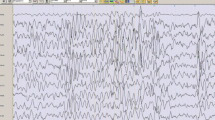Abstract
In order to assess the accuracy of electroencephalography (EEG), in children who have undergone cardiac surgery under simple deep hypothermia, the relation between IQ or schoolwork achievement and the duration of circulatory arrest was investigated in 75 such children. Abnormal preoperative EEG's were found in 16 per cent of the children while abnormal postoperative EEG's were found in 17 per cent. The children were divided into 4 groups, according to pre- and postoperative EEG results. Schoolwork achievement scores ranged between 3.0 and 3.2, the difference among the groups being insignificant. Moreover, no significant shift in IQ was found among the groups. Finally, regarding the number of children who were able to go on to a higher level of education, including high school the college or university, again no significant differences were found among the 4 groups. In a comparison with the number of such children in neighboring Nagasaki prefecture able to continue on to a higher level of education, no significant differences were seen either. The findings and statistics of this investigation therefore indicate that pre- and postoperative EEG's are not always a reliable reference for assessing the prognosis of cerebral activity.
Similar content being viewed by others
References
Bjork VO, Hultquist G. Contraindications to profound hypothermia in open-heart surgery. J Cardiovasc Surg 1962; 44: 1–13.
Wright JS, Hicks RG, Newman DC. Deep hypothermic arres: observations on later development in children. J Thorac Cardiovasc Surg 1979; 77: 466–468.
Messmer BJ, Schallberger U, Gattiker R, Senning A. Psychomotor and intellectual development after deep hypothermia and circulatory arrest in early infancy. J Thorac Cardiovasc Surg 1976; 72: 495–502.
Hirabayashi Y, Yamauchi T, Mohri Y, Kataoka N, Ohta S, Yokota, Tamura M, Machida S, Fukuda M, Ohashi K. EEG changes following open-heart surgery. Rinshou Nouha (Clin Electroenceohalography) 1976; 18: 345–352. (in Japanese)
Hirabayashi Y, Yamauchi T, Kataoka N, Takasaka Y, Ohta S, Maeda Y, Fukuda M, Ishii E, Ohashi K, Fukuda N. EEG changes and central nervous system complication in open-heart surgery. Rinshou Nouha (Clin Electroenceohalography) 1978; 20: 501–509. (in Japanese)
Inokawa K, Morimoto M, Ikeda Y, Tsugane J, Yuzuriha H, Shida H. Cerebral disorder after open-heart surgery in infants undergoing hypothermic circulatory arrest. Nippon Syoni Geka Gakkai Zasshi (J Jpn Soc Pediatr Surg) 1981; 17: 1189–1192. (in Japanese with English Abst.)
Itoh T. An investigation of the intellectual and physical development of children following radical open heart surgery using hypothermia. Nippon Kyobu Geka Gakkai Zasshi (J Jpn Assoc Thorac Surg) 1980; 28: 1222–1228. (in Japanese with English Abst.)
Dickinson DF, Sambrooks JE. Intellectual performance in children after circulatory arrest with profound hypothermia in infancy. Arch Dis Child 1979; 54: 1–6.
Wells FC, Coghill S, Caplan HL, Lincoln C. Duration of circulatory arrest does influence the psychological development of children after cardiac operation in early life. J Thorac Cardiovasc Surg 1983; 86: 823–831.
Araki J, Sato S, Ito T, Ohmi M, Kahata O, Yokoyama A, Tadokoro M, Horiuchi T, Mohri H. Chinical study of the hypothermic circulatory arrest in central nervous systems in open heart surgery. Nippon Kyobu Geka Gakkai Zasshi (J Jpn Assoc Thorac Surg) 1982; 30 1406–1412. (in Japanese with English Abst.)
Iwamoto I, Baba N, Uchida N, Matsuo K, Koga Y. Evaluation of somatic and intellectual development after deep hypothermic circulatory arrest in infants and children. Nippon Kyobu Geka Gakkai Zasshi (J Jpn Assoc Thorac Surg) 1988; 36: 214–220. (in Japanese with English Abstr.)
Clarkson PM, MacArthur BA, Barratt-Boyes BG, Whitlock RM, Neutze JM. Developmental progress after cardiac surgery in infancy using hypothermia and circulatory arrest. Circulation 1980; 62: 855–861.
Watanabe Y, Kawamura Y, Iwa T. Brain damage after deep hypothermia in dogs. Jpn J Surg 1982; 12: 61–70.
Iwamoto I, Baba H, Koga Y, Uchida N, Matsuo K, Hirota N. Evaluation of encephalograms following open heart surgery under deep hypothermia. Nagasaki Igakkai Zasshi (Nagasaki Med J) 1989; 63: 457–461. (in Japanese with English Abst.)
Fischer-Williams M, Cooper RA. Some aspects of electroencephalographic changes during openheart surgery. 1964; Neurology 14: 472–482.
Cohen ME, Olszowka JS, Subramanian S. Electroencephalographic and neurological correlates of deep hypothermia and circulatory arrest in infants. Ann Thorac Surg 1977; 23: 238–244.
Author information
Authors and Affiliations
Rights and permissions
About this article
Cite this article
Iwamoto, I., Baba, H., Koga, Y. et al. The relation between EEG and mental development following cardiac surgery performed under simple deep hypothermia in children. The Japanese Journal of Surgery 20, 158–162 (1990). https://doi.org/10.1007/BF02470763
Received:
Issue Date:
DOI: https://doi.org/10.1007/BF02470763




